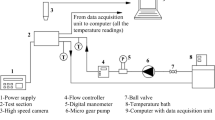Abstract
Pulsating heat pipes (PHPs) have promised to be effective heat spreaders. From the fabrication perspective, the PHPs are less intensive than their conventional counterparts. Despite the advantages, there still exists shortage of data in both experimental and analytical domains towards reliable design and prediction of PHP performance. In this study, a flat plate closed loop PHP has been experimentally investigated for its thermal performance. The PHP with 12 channels, each 2.2 mm deep × 2.0 mm wide, was tested with deionized water for a fill ratio of 70% by volume for various orientations starting from vertical evaporator below condenser (90°) to near horizontal (7.5°) orientation for a single heat load of 50 W to calibrate the test setup against published literature. The PHP was also tested for methanol with various fill ratios (30, 40, 50, 60 and 70%) for 50 W. The best performing fill ratio of methanol was tested for various heat loads (10 to 100 W) for the vertical and the near horizontal orientation. An attempt has been made to resolve the critical angle after which the PHP ceases to perform when tilted towards horizontal orientation. The PHP performance as expected was best at the 90° (vertical) orientation with very little deterioration up to 45°. The thermal resistances were estimated for two fluids, for various orientations, heat loads and fill ratios. The results indicate that at near horizontal orientation methanol performed better than water for 70% fill ratio. The 40% fill ratio of methanol yielded the least thermal resistance for all orientations. Also the thermal resistance of the PHP decreased with increasing heat load for different orientations. The PHP operated successfully up to 7.5–10° below which the PHP was observed to have dry out.















Similar content being viewed by others
Abbreviations
- Acs :
-
Heat transfer cross-sectional area in solid m2
- Ac :
-
Cross-sectional area of channel mm2
- Bo:
-
Bond number
- D:
-
Diameter of the channel mm
- Dh :
-
Hydraulic diameter of channel mm
- (dP/dT)sat :
-
Change in pressure for a given change in temperature at saturated condition Pa/K
- g:
-
Acceleration due to gravity m/s2
- I:
-
Current supplied to heater A
- k:
-
Thermal conductivity of solid W/m-°C
- L:
-
Distance between evaporator and condenser mm
- P:
-
Pressure of fluid Pa
- Pw :
-
Perimeter of channel mm
- \( \overset{.}{Q} \) :
-
Heat supplied to heater W
- R:
-
Centreline radius of the bend of the channel mm
- RAl/PC :
-
Thermal resistance due to conduction in solid °C/W
- Rempty :
-
Thermal resistance of PHP without fluid °C/W
- Rth :
-
Thermal resistance of PHP °C/W
- RPHP :
-
Thermal resistance due to PHP effect °C/W
- ∆T:
-
Temperature drop: evaporator – condenser °C
- T:
-
Temperature of fluid °C
- Tc :
-
Temperature at condenser °C
- Te :
-
Temperature at evaporator °C
- V:
-
Voltage supplied to heater V
- ρl :
-
Density of liquid kg/m3
- ρv :
-
Density of vapour kg/m3
- σ:
-
Surface tension of liquid N/m
- β:
-
Inclination angle degrees
- θ:
-
Contact angle (solid-fluid) degrees
References
Zhang Y, Faghri A (2008) Advances and unsolved issues in pulsating heat pipes. Heat Transfer Eng 29(1):20–44. https://doi.org/10.1080/01457630701677114
Reay DA et al (2014) Heat pipes – theory, design and applications. Elsevier, Oxford, pp 142–149. Chap.-7
Rittidech S et al (2003) Correlation to predict heat transfer characteristics of a closed-end oscillating heat pipe at Normal operating condition. Appl Therm Eng 23:497–510. https://doi.org/10.1016/S1359-4311(02)00215-6
Groll M, Khandekar S (2003) Pulsating heat pipes: progress and prospects. In: Proc of international conference on energy and environment, vol 1, pp 723–730
Khandekar S, Groll M (2003) On the definition of pulsating heat pipes: an overview. In: Proc. of 5th Minsk International Seminar (Heat Pipes, Heat Pumps and Refrigerators), Minsk, Belarus
Khandekar S et al (2003) Thermofluid dynamic study of flat plate closed loop pulsating heat pipes. Microscale Therm Eng 6(4):303–317. https://doi.org/10.1080/10893950290098340
Han H et al (2014) A comparative study of the behaviour of working fluids and their properties on the performance of pulsating heat pipes. Int J Therm Sci 82:138–147. https://doi.org/10.1016/j.ijthermalsci.2014.04.003
Yang H et al (2009) Performance characteristics of pulsating heat pipes as integral thermal spreaders. Int J Therm Sci 48(4):815–824. https://doi.org/10.1016/j.ijthermalsci.2008.05.017
Kearney D, Griffin J (2014) An open loop pulsating heat pipe for integrated electronic cooling applications. ASME J Heat Transfer 136(8):081401. https://doi.org/10.1115/1.4027131
Kilne SJ, Mc Clintock FA (1953) Describing uncertainties in single-sample experiments. Mechanical Engineering 75:3–8
Charoensawan P et al (2003) Closed loop pulsating heat pipes part a: parametric experimental investigations. Appl Therm Eng 23:2009–2020
Chien K et al (2012) A novel design of pulsating heat pipe with fewer turns applicable to all orientations. Int J Heat Mass Transf 55:5722–5728. https://doi.org/10.1016/j.ijheatmasstransfer.2012.05.068
Mameli M et al (2014) Local heat transfer measurement and thermo-fluid characterization of a pulsating heat pipe. Int J Therm Sci 75:140–152. https://doi.org/10.1016/j.ijthermalsci.2013.07.025
Cengel YA (2003) Heat transfer - a practical approach. Tata McGraw-Hill, New Delhi
Pigott RJS (1950) Pressure losses in tubing, pipe and fittings. Trans ASME 72:679–688
Acknowledgements
The authors (P Srikrishna and N Siddharth) thank the Director, MTRDC, for providing the opportunity and encouragement in carrying out the tasks presented in the paper.
Author information
Authors and Affiliations
Corresponding author
Additional information
Publisher’s note
Springer Nature remains neutral with regard to jurisdictional claims in published maps and institutional affiliations.
Rights and permissions
About this article
Cite this article
Srikrishna, P., Siddharth, N., Reddy, S.U.M. et al. Experimental investigation of flat plate closed loop pulsating heat pipe. Heat Mass Transfer 55, 2637–2649 (2019). https://doi.org/10.1007/s00231-019-02607-z
Received:
Accepted:
Published:
Issue Date:
DOI: https://doi.org/10.1007/s00231-019-02607-z




